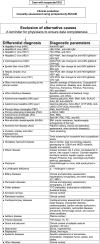Drug induced liver injury with analysis of alternative causes as confounding variables
- PMID: 29607530
- PMCID: PMC6005631
- DOI: 10.1111/bcp.13593
Drug induced liver injury with analysis of alternative causes as confounding variables
Abstract
Aims: Drug-induced liver injury (DILI) is rare compared to the worldwide frequent acute or chronic liver diseases. Therefore, patients included in series of suspected DILI are at high risk of not having DILI, whereby alternative causes may confound the DILI diagnosis. The aim of this review is to evaluate published case series of DILI for alternative causes.
Methods: Relevant studies were identified using a computerized search of the Medline database for publications from 1993 through 30 October 2017. We used the following terms: drug hepatotoxicity, drug induced liver injury, hepatotoxic drugs combined with diagnosis, causality assessment and alternative causes.
Results: Alternative causes as variables confounding the DILI diagnosis emerged in 22 published DILI case series, ranging from 4 to 47%. Among 13 335 cases of suspected DILI, alternative causes were found to be more likely in 4555 patients (34.2%), suggesting that the suspected DILI was probably not DILI. Biliary diseases such as biliary obstruction, cholangitis, choledocholithiasis, primary biliary cholangitis and primary sclerosing cholangitis were among the most missed diagnoses. Alternative causes included hepatitis B, C and E, cytomegalovirus, Epstein-Barr virus, ischemic hepatitis, cardiac hepatopathy, autoimmune hepatitis, nonalcoholic fatty liver disease, nonalcoholic steatohepatitis, and alcoholic liver disease.
Conclusions: In more than one-third of published global DILI case series, alternative causes as published in these reports confounded the DILI diagnosis. In the future, published DILI case series should include only patients with secured DILI diagnosis, preferentially established by prospective use of scored items provided by robust diagnostic algorithms such as the updated Roussel Uclaf causality assessment method.
Keywords: Roussel Uclaf Causality Assessment Method; alternative causes; causality assessment; competing causes; drug-induced liver injury; missed diagnoses.
© 2018 The British Pharmacological Society.
Figures


Similar articles
-
Drug induced liver injury: accuracy of diagnosis in published reports.Ann Hepatol. 2014 Mar-Apr;13(2):248-55. Ann Hepatol. 2014. PMID: 24552867 Review.
-
Herbal hepatotoxicity: suspected cases assessed for alternative causes.Eur J Gastroenterol Hepatol. 2013 Sep;25(9):1093-8. doi: 10.1097/MEG.0b013e3283603e89. Eur J Gastroenterol Hepatol. 2013. PMID: 23510966 Review.
-
Top-ranking drugs out of 3312 drug-induced liver injury cases evaluated by the Roussel Uclaf Causality Assessment Method.Expert Opin Drug Metab Toxicol. 2018 Nov;14(11):1169-1187. doi: 10.1080/17425255.2018.1539077. Epub 2018 Oct 29. Expert Opin Drug Metab Toxicol. 2018. PMID: 30354694 Review.
-
Idiosyncratic DILI: Analysis of 46,266 Cases Assessed for Causality by RUCAM and Published From 2014 to Early 2019.Front Pharmacol. 2019 Jul 23;10:730. doi: 10.3389/fphar.2019.00730. eCollection 2019. Front Pharmacol. 2019. PMID: 31396080 Free PMC article. Review.
-
Advances in Idiosyncratic Drug-Induced Liver Injury Issues: New Clinical and Mechanistic Analysis Due to Roussel Uclaf Causality Assessment Method Use.Int J Mol Sci. 2023 Jun 29;24(13):10855. doi: 10.3390/ijms241310855. Int J Mol Sci. 2023. PMID: 37446036 Free PMC article. Review.
Cited by
-
The Development of a Database for Herbal and Dietary Supplement Induced Liver Toxicity.Int J Mol Sci. 2018 Sep 28;19(10):2955. doi: 10.3390/ijms19102955. Int J Mol Sci. 2018. PMID: 30274144 Free PMC article.
-
Liraglutide-Induced Hepatotoxicity.Biomedicines. 2021 Jan 22;9(2):106. doi: 10.3390/biomedicines9020106. Biomedicines. 2021. PMID: 33498980 Free PMC article.
-
Bactrim-Induced Hepatotoxicity.Cureus. 2024 Nov 19;16(11):e74053. doi: 10.7759/cureus.74053. eCollection 2024 Nov. Cureus. 2024. PMID: 39712800 Free PMC article.
-
Alcoholic Liver Disease: Alcohol Metabolism, Cascade of Molecular Mechanisms, Cellular Targets, and Clinical Aspects.Biomedicines. 2018 Nov 12;6(4):106. doi: 10.3390/biomedicines6040106. Biomedicines. 2018. PMID: 30424581 Free PMC article. Review.
-
Treatment of Drug-Induced Liver Injury.Biomedicines. 2022 Dec 21;11(1):15. doi: 10.3390/biomedicines11010015. Biomedicines. 2022. PMID: 36672522 Free PMC article. Review.
References
-
- Shahbaz O, Mahajan S, Lewis JH. Highlights of drug‐ and herb‐induced liver injury in the literature from 2016: how best to translate new information into clinical practice? Exp Opin Drug Metab Tox 2017; 13: 935–951. - PubMed
-
- Sarges P, Steinberg JM, Lewis JH. Drug‐induced liver injury: highlights from a review of the 2015 literature. Drug Saf 2016; 39: 561–575. - PubMed
-
- Teschke R, Danan G. Causality assessment methods in drug‐induced liver injury In: Drug‐induced liver toxicity (Chapter 27), Series: Methods in Pharmacology and Toxicology (Y. James Kang & David C. Casey. Springer Protocols), eds Chen M, Will Y. Berlin Germany: Springer Nature, 2018, pp. 555–594.
-
- Teschke R, Danan G. Drug‐induced liver injury: is chronic liver disease a risk factor and a clinical issue? Expert Opin Drug Metab Toxicol 2017; 13: 425–438. - PubMed
-
- Chen M, Borlak J, Tong W. High lipophilicity and high daily dose of oral medications are associated with significant risk for drug‐induced liver injury. Hepatology 2013; 58: 388–396. - PubMed
Publication types
MeSH terms
LinkOut - more resources
Full Text Sources
Other Literature Sources
Medical

